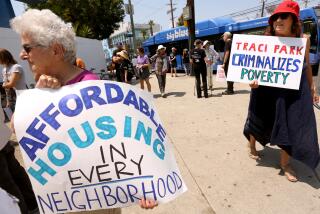Ruth Schwartz, pioneer of homeless services in L.A., dies
In the early days of the COVID-19 pandemic, when governments and corporations were fighting over personal protective gear, Ruth Schwartz foresaw that those she had dedicated her life to — the shelters and agencies serving L.A. County’s poorest — would not thrive in that competition.
And she knew what to do. Schwartz turned to the companies that donate millions of dollars worth of new goods each year to Shelter Partnership, the venerable Los Angeles charity that distributes those goods to organizations serving those in need.
Through her leadership, Shelter Partnership was able to secure over 1.5 million face masks, 6 semitrucks of hand sanitizer and other items such as hand soap, said Jennifer Marquez, who handles product donations for the nonprofit.
Schwartz, who co-founded Shelter Partnership in 1985 and continued to lead it as its sole executive director, died Friday while visiting a friend in Santa Barbara. She was 71.
As news of her death raced through homeless services circles, Schwartz was remembered as an activist of deep empathy and unyielding passion who was a living link to the formative days of the region’s battle with growing homelessness.
“She was homelessness before Measure H, Proposition HHH, the ad hoc committee on Black homelessness,” said Jack Barbour, chief executive of the Southern California Health & Rehabilitation Program, one of the many organizations Schwartz helped get on its feet.
Barbour said he met Schwartz in the late 1990s when she attended a meeting of mental health providers to talk about the then-new idea called housing first.
“Nobody paid any attention to that,” Barbour said. “My nonprofit jumped at it.”
Schwartz’s knowledge and connections helped capitalize a project to rehabilitate 14 units into permanent housing for homeless people.
And when the project opened, she came in person.
“She met the clients,” Barbour said. “They were charming. You could see in her face the exhilaration she had that these units were put to the use she had envisioned.”
Largely working out of public view, Schwartz built Shelter Partnership into a multipronged organization that provided policy advocacy, technical advice and research, but was best known for its gigantic supply depot in the city of Bell.
The S. Mark Taper Foundation Shelter Resource Bank takes in durable goods directly from corporate donors and processes them through an Amazon-like warehouse for delivery to more than 200 nonprofits. Since 1989, more than $267 million in furniture, bedding, clothing, diapers and cleaning supplies have been distributed free to nonprofits that serve homeless people.
Schwartz oversaw the operation with a personal touch.
“She would call me, ‘Are you guys picking your stuff up?’” said Joel John Roberts, chief executive officer of PATH, a statewide homeless services and housing nonprofit. “‘Of course, Ruth.’ She’d say you didn’t get enough. You should be getting more.”
Originally from Chicago, Schwartz grew up in the San Fernando Valley, graduated from Cal State Northridge and received a master’s degree in urban planning from UCLA.
Schwartz worked for the California Coastal Commission in Santa Barbara and then the California Department of Housing and Community Development.
In the mid-1980s, she returned to Los Angeles with a vision.
Meeting with Mayor Tom Bradley’s young homelessness aide, Wendy Greuel, a future councilwoman and current chair of the Los Angeles Homeless Services Authority, Schwartz was direct.
“She asked me if I was old enough to have my job,” Greuel recalled. “That was Ruth, dogged and determined and never took no for an answer.”
She wanted to create an organization to advise and support all the nonprofits popping up to address homelessness.
“It was Ruth’s vision,” Greuel said. “She brought us all along. Tom Bradley particularly appreciated the simplicity of what she was trying to do and yet the breadth of impact.”
Initially the mission was to influence public policy and provide technical support, particularly helping startup nonprofits write grant proposals. But as word got out, Schwartz began receiving requests from retailers and manufacturers wanting to donate excess goods.
It started with 1,000 raincoats that Schwartz stuffed into her Volvo sedan and delivered to local shelters. Then she got a trucking firm to deliver $100,000 worth of children’s clothing.
Enter federal Judge Harry Pregerson, who had negotiated the release of part of the decommissioned Cheli Air Force Station in Bell to the Salvation Army for a homeless shelter. Pregerson introduced Schwartz to Louise Oliver, deputy director of Southern California property for the U.S. General Services Administration.
Within two weeks, Oliver negotiated a no-cost lease on a 30,000-square-foot warehouse. Three moves later, the agency acquired and refurbished a 108,000-square-foot building on the former base.
“Some of our most interesting donations included 163 pallets of disposable razors, 3,000 youth tuxedos, and 2,576 rolls of carpet,” Schwartz wrote in a 2014 history of Shelter Partnership. “Every donation we received, no matter how unique, ended up at an agency and not in a landfill.”
As nonprofits such as PATH and LA Family Housing grew into homeless powerhouses, and the city and county formed the Los Angeles Homeless Services Authority to coordinate, Schwartz took more of a background role, but never hesitated to speak bluntly about how the system could work better.
“Ruth was the person who would say in a meeting what everybody else was thinking but didn’t want to say out loud,” said Dhakshike Wickrema, homelessness deputy for Mark Ridley-Thomas, both as supervisor and now councilman. “She would say exactly what she thought to whomever. She would cut through all the trappings and get right to the heart of the matter.”
Better efficiency, more transparency and more emphasis on the most needy were her constant refrains.
“She was lifting up the issue of homelessness decades before anyone else was paying attention to it,” said Sarah Dusseault, a homelessness advisor to mayors and currently a LAHSA commissioner. “Her focus remained and always was on the very poorest.”
At the time of her death, Schwartz was in Santa Barbara visiting her old friend and long-ago roommate Carol Galante, faculty director of the Terner Center for Housing Innovation at UC Berkeley.
“She was in great spirits and had just finished doing a few laps of swimming in the pool and that was something she missed doing during the pandemic,” Galante said.
Then she said she did not feel well and later stopped breathing. Paramedics were unable to revive her, Galante said.
Even though it was a social visit, they had, of course, talked business, Galante said. Schwartz talked about being proud of Shelter Partnership’s contributions in the pandemic, but also worried about the toll the extra work took on the staff.
“She was really an incredibly generous person in spirit,” Galante said. When a lunch bill came, Galante recalled, “she said, ‘I think we should leave a 30% tip. These people have been out of work.’”
Schwartz is survived by a brother, a sister and several nieces and nephews.
More to Read
Start your day right
Sign up for Essential California for the L.A. Times biggest news, features and recommendations in your inbox six days a week.
You may occasionally receive promotional content from the Los Angeles Times.







